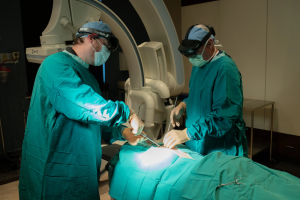The FDA has given its approval to a pioneering product in the precision spine surgery space. Novarad’s new, fully immersive surgical navigation system uses the powers of 3D and augmented reality to give surgeons expert guidance in navigating patients’ anatomy as procedures are planned and performed.
The technology, dubbed VisAR, germinated from the company’s ambition to create a visualization system with a streamlined setup at a lower price point. To that end, VisAR’s namesake augmented reality tech is more operationally straightforward—thanks to direct superimposition of a surgical navigation plan over a patient’s body—and can be sold for a fraction of the cost of competing systems due to incorporation of off-the-shelf AR hardware. “This is transformational technology that provides the precision of a robot, the portability of a stethoscope, and the versatility of human-powered intelligence,” said Dr. Wendell Gibby, Novarad’s Chief Executive Officer. “Like a surgical GPS, VisAR provides a road map to guide the surgeon to the pathology of interest.”
The VisAR platform’s preparatory offerings for surgery give physicians advanced means to analyze patient imaging data, with features including virtual annotations and collected scan segmentation. That data is then visualized as a 2D or 3D immersive hologram that can map directly on the body, and CT scan-based markers help accurately position that hologram. Pedicle screw placement, for instance, can reportedly be made accurate to within two millimeters with VisAR. Estimated set-up times for the system’s use in an operating room top out at roughly two minutes.























